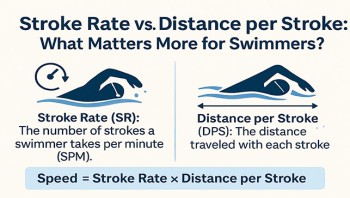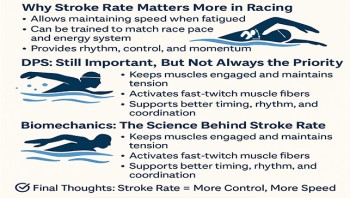Stroke Rate vs. Distance per Stroke in Swimming
Stroke Rate vs. Distance per Stroke: What Matters More for Swimmers?
Swimming fast isn’t just about strength—it’s about how efficiently you move through the water. Two key factors that determine your speed are stroke rate (how fast you take strokes) and distance per stroke (how far you move with each stroke). But when you have to choose which one to focus on, stroke rate often wins—especially in competitive swimming.
Let’s dive in.

🔄 What Are Stroke Rate and Distance per Stroke?
Stroke Rate (SR): The number of strokes a swimmer takes per minute (SPM). Think of it like the swimmer’s cadence or tempo.
Distance per Stroke (DPS): The distance you travel with each arm stroke.
They work together to create speed:
📐 Speed = Stroke Rate × Distance per Stroke
You can’t improve speed without managing both—but how you manage them depends on your goals and event distance.
🏁 Why Stroke Rate Matters More in Racing
When races are short or intense, swimmers can’t rely on gliding forever. They need fast, consistent movement. That’s where stroke rate becomes key.
Here’s why:
A higher stroke rate allows you to maintain speed even as you fatigue.
Stroke rate can be trained to match your race pace and energy system.
It gives you rhythm, control, and momentum, which are crucial for turns and finishes.
Look at elite sprinters like Caeleb Dressel—they maintain very high stroke rates while still keeping strong technique. Their success shows that speed favors smart, rapid turnover over long, slow strokes.
🧭 DPS: Still Important, But Not Always the Priority
Don’t get us wrong—distance per stroke is important. It reflects how efficient your stroke is. A longer stroke means you’re using energy wisely.
But here’s the catch:
Focusing too much on DPS can lead to overgliding—pausing between strokes and losing speed.
It can break your rhythm, especially in shorter races.
High DPS can be helpful in long-distance swimming, where energy conservation matters more than raw speed.
So, while a long stroke looks smooth, it can be too slow for racing if it’s not paired with a good stroke rate.
⚙️ Biomechanics: The Science Behind Stroke Rate
High stroke rate works because it matches how your body moves best under pressure:
It keeps your muscles engaged and maintains tension in the water.
It helps activate fast-twitch muscle fibers, which are responsible for quick, explosive actions—perfect for sprinting.
It supports better timing, rhythm, and coordination.
With a higher stroke rate, your body avoids the energy drop that can come from slowing down between strokes.
📱 How Swimmers and Coaches Track Stroke Rate
Modern tools make it easy to track and train stroke rate:
Tempo Trainers help swimmers keep a consistent stroke rhythm.
Underwater video lets coaches analyze stroke efficiency in real time.
Data from wearables and smart goggles provides instant feedback on stroke count, rate, and timing.
Coaches use this info to find the ideal balance for each swimmer based on body type, event, and technique.
🧠 Strategy: Training for the Right Stroke Rate
Stroke rate isn’t just about going faster—it’s about going smarter. Training with stroke rate in mind helps:
Adjust pacing strategies for different events
Prevent energy waste
Stay fast under fatigue
Swimmers can learn to shift stroke rate throughout a race: slower in the first 50 meters, then build up for a strong finish. This gives them more control over their performance.

✅ Final Thoughts: Stroke Rate = More Control, More Speed So, what should you choose—stroke rate or distance per stroke?
🔑 The answer: Both matter, but stroke rate gives you more tools to win.
DPS tells you how efficient you are.
SR tells you how fast and responsive you can be.
In modern swimming—especially sprint and mid-distance events—stroke rate gives swimmers the edge. It offers more adaptability, better pacing, and greater control when it matters most.
Work on keeping your stroke efficient, but don’t be afraid to increase your tempo. High stroke rate, done right, leads to high performance.